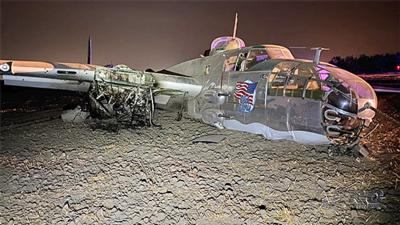Sum of a Ditch
On 19 September 2020, a North American B-25N Mitchell, registration N7946C, suffered substantial damage after losing engine power and coming to ground in a field near California’s Stockton Metropolitan Airport (SCK).

While the airplane was in cruise flight under the control of the the Second In Command (SIC), the left engine fuel pressure fluctuated. A momentary loss of engine power ensued. Concerned a failure of the aircraft’s engine-driven fuel pump may have occurred, the Pilot In Command (PIC) activated the B-25’s electric boost pumps, switching them to high, and directed a passenger—who happened to be the aircraft’s mechanic—to open the WWII era bomber’s fuel cross-feed valve.
As the airplane approached SCK, its intended landing airport, both fuel pressure needles began to fluctuate. Assuming engine fuel starvation, the PIC—owing to residential areas lying between the airplane’s position and the airport—elected to attempt an off-airport landing in a field then behind the aircraft.
The PIC stated he took control of the airplane from the SIC and initiated a right turn toward the selected landing field. Shortly thereafter, both the B-25’s engines suffered total power loss.
The aircraft touched down in a controlled fashion. However, during the landing roll, the PIC observed a ditch in the B-25’s path of travel. Applying back-elevator-pressure, the PIC succeeded in getting the aircraft briefly re-airborne, thereby avoiding subject ditch.

Regrettably, a second, larger ditch lie beyond the first. As insufficient airspeed remained to attain flight—even in ground-effect—the aircraft struck the second ditch, became momentarily airborne, and impacted the ground, resulting in substantial damage to the fuselage.
Two of the aircraft’s occupants suffered serious injuries. A third suffered minor injuries.
Salvage personnel reported that during recovery of the B-25’s wreckage, approximately one-gallon of fuel was removed from its two forward and two aft wing tanks. Post-accident examination of the aircraft revealed no evidence of pre-existing anomalies that would have precluded normal operation of either engine—excepting the fact that all four main engine fuel-tank gauges displayed erroneous indications after their respective tanks were filled with water.
The B-25’s fuel system was determined to be free of leaks.
The airplane was fueled with 497.7 gallons of avgas the day prior to the accident—at which time the tanks were reportedly filled to approximately three-inches below the fuel-filler neck.
Investigators could not determine, based on available data and evidence, how much of the aircraft’s maximum 670-gallon fuel capacity had been transferred into its tanks during its last fueling.
Additionally, the PIC reported that, for flight-planning purposes, he commonly calculated the aircraft’s fuel-burn at 150-gallons per flight-hour—a figure that included takeoff fuel-burn.

Recorded Automatic Dependent Surveillance-Broadcast (ADS-B) data showed the B-25 had flown four-hours and one-minute since its last refueling. The time included six take-offs and five landings, but did not include taxi times. For purposes germane to the investigation, the PIC estimated 485.9-gallons of avgas had been used since the B-25’s last refueling. However, on the basis of the PIC’s initial planned fuel load and recorded flight times, the airplane would, in actuality, have burned approximately six-hundred-gallons. The B-25’s flight manual contained no fuel-burn references for the exact power settings and altitudes flown during the aircraft’s final flight. Ergo, the B-25’s actual hourly fuel-burn could not be determined.
The PIC, SIC, and passenger did not visually verify the fuel levels in all four main fuel tanks prior to the accident flight. Furthermore, the PIC underestimated the amount of fuel required for the planned flight and its numerous take-offs and landings. The oversight resulted in fuel-exhaustion, which in turn resulted in a total loss of engine power.
The National Transportation Safety Board (NTSB) determined the probable cause(s) of the accident to be a total loss of engine power attributable to fuel exhaustion. Contributing to the accident were the erroneous fuel-gauge indications and inadequate preflight planning and aircraft inspection.
 ANN's Daily Aero-Term (04.30.24): Runway Centerline Lighting
ANN's Daily Aero-Term (04.30.24): Runway Centerline Lighting ANN's Daily Aero-Linx (04.30.24)
ANN's Daily Aero-Linx (04.30.24) Airborne 04.24.24: INTEGRAL E, Elixir USA, M700 RVSM
Airborne 04.24.24: INTEGRAL E, Elixir USA, M700 RVSM Airborne 04.29.24: EAA B-25 Rides, Textron 2024, G700 Deliveries
Airborne 04.29.24: EAA B-25 Rides, Textron 2024, G700 Deliveries Airborne-NextGen 04.23.24: UAVOS UVH 170, magni650 Engine, World eVTOL Directory
Airborne-NextGen 04.23.24: UAVOS UVH 170, magni650 Engine, World eVTOL Directory





